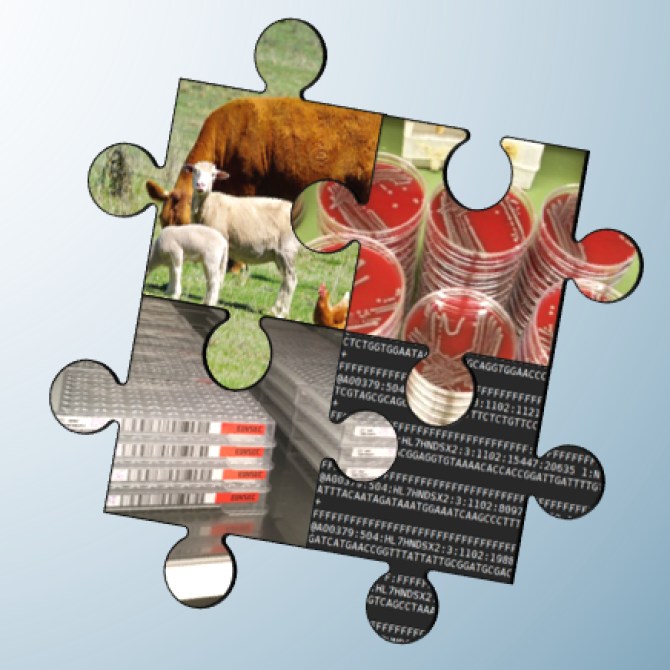
News
Implementation of Whole-Genome Sequencing for AMR monitoring in livestock and meat
The National Reference Laboratory on Antimicrobial Resistance of Wageningen Bioveterinary Research (WBVR), in close cooperation with Wageningen Food Safety Research (WFSR) started whole genome sequencing (WGS) of all ESBL/AmpC-producing E. coli isolates to replace phenotypic antimicrobial susceptibility testing and additional PCR testing. The results thus far show that WGS discloses additional information on the transmission of Antimicrobial Resistance (AMR) within animal species.
The monitoring of antimicrobial resistance (AMR) in food-producing animals and food is essential to provide reliable information on the development and spread of antibiotic resistance. Resistance data are used for determining the impact of measures taken to reduce AMR which is essential information for policy makers. This monitoring is envisioned to be performed in close connection with the monitoring of antimicrobial usage (AMU in food-producing animals and is linked to the AMR and AMU monitoring programmes in humans, intended to deliver insights on how to tackle AMR from a One Health approach.
Monitoring
Since 2014, selective culturing of ESBL/AmpC-producing Escherichia coli of caecal samples from food-producing animals collected at slaughter and retail meat is a mandatory part of the European resistance monitoring program. It provides important complementary information to the resistance monitoring of indicator E. coli regarding the prevalence and spread of ESBL/AmpC-producing E. coli in livestock and supports source attribution research to determine the potential risk of spread of ESBL/AmpC-producing E. coli from animal populations and food to humans.
Susceptibility
Routinely, antimicrobial susceptibility of ESBL/AmpC-producing E. coli are tested by broth microdilution in two European antibiotic panels. The first panel consists of fourteen antibiotics covering antibiotic classes relevant for public health. The second panel is designed to determine the phenotypic characteristics of ESBL-, AmpC- and carbapenemase producers and comprises different beta-lactam antibiotics such as third and fourth generation cephalosporins and a number of carbapenem antibiotics.

Sequencing
Recently, the European legislation for AMR monitoring in livestock and food (Commission Implementing Decision (EU) 2020/1729) allowed WGS to be used on a voluntary basis for ESBL/AmpC-producing E. coli. Consequently, the National Reference Laboratory on Antimicrobial Resistance of Wageningen Bioveterinary Research (WBVR) in close cooperation with Wageningen Food Safety Research (WFSR) started whole genome sequencing (WGS) of all ESBL/AmpC-producing E. coli isolates to replace phenotypic antimicrobial susceptibility testing and additional PCR testing.
As a result short-read sequencing (Illumina platform) and WGS based analysis were performed to: (a) detect the antibiotic resistance genes present using the ResFinder database and (b) to determine possible clonal relatedness of E. coli isolates using whole-genome alignment and core genome SNP analysis.
Comparison
In brief, phenotypic and genotypic data of 338 selectively isolated ESBL/AmpC-producing E. coli from livestock and retail meat were compared. For this data set, a correlation of 90% or higher was identified between the tested resistance phenotype and the predicted phenotype based on the detected genotypes for all antibiotic classes. Various beta-lactam phenotypes were measured which correlated 94-100% with the detected ESBL/AmpC genes.
Clusters
Further analysis of the short-read sequence data revealed the presence of 15 clonally related clusters comprising of 39 isolates, in which the total core genome contained 40 SNPs or less. These clusters were identified within the different livestock sectors (cattle: including both veal calves and dairy cows, slaughter pigs and broiler chickens and meat thereof), but no clusters were detected amongst samples of faecal content or meat across the different livestock sectors.
Advantages
These results clearly demonstrate the advantages of using WGS for AMR monitoring. Added value lies in the wealth of additional information hidden in the WGS data, used here for epidemiological purposes, which demonstrates clonal relationships within the livestock sectors.
The results indicate horizontal spread of ESBL/AmpC-producing E. coli between farms within livestock sectors. This new insight can facilitate the development of intervention measures to stop the spread of ESBL/AmpC-producing E. coli within livestock sectors, ultimately leading to reduction of these resistant bacteria on meat.